|
| OVERALL PROGRESS? |
 |
Domestic trips(a) involving nature activities(b)(c) |
 |  |  |
 |  |  |
Headline progress indicator |  | ...involving going to the beach |
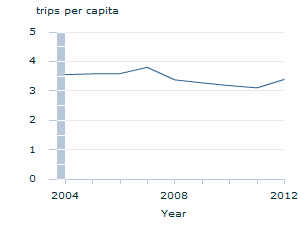
Footnote:
(a) Includes both overnight and day trips.
(b) See the glossary on the further info page for a definition of 'Nature activities'.
(c) Persons aged 15 years and over.
Source:
Tourism Research Australia 2013 (unpublished data)
ABS Population by Age and Sex, Regions of Australia, 2012 (cat. no. 3235.0) |  | 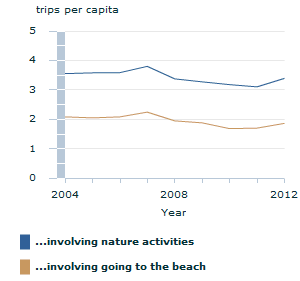
Footnote:
(a) Includes both overnight and day trips.
(b) See the glossary on the further info page for a definition of 'Nature activities'.
(c) Persons aged 15 years and over.
Source:
Tourism Research Australia 2013 (unpublished data)
ABS Population by Age and Sex, Regions of Australia, 2012 (cat. no. 3235.0) |
 |  | |
 |  |  |
 |  |  |
|
| ACCESS TO AND AVAILABILITY OF NATURE AREAS |
 |
Domestic trips(a) involving nature activities(b)(c) |
 |  |  |
 |  |  |
Progress indicator |  | ...involving going to the beach |
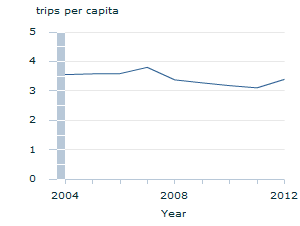
Footnote:
(a) Includes both overnight and day trips.
(b) See the glossary on the further info page for a definition of 'Nature activities'.
(c) Persons aged 15 years and over.
Source:
Tourism Research Australia 2013 (unpublished data)
ABS Population by Age and Sex, Regions of Australia, 2012 (cat. no. 3235.0) |  | 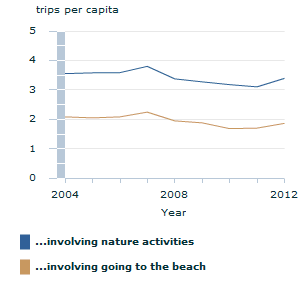
Footnote:
(a) Includes both overnight and day trips.
(b) See the glossary on the further info page for a definition of 'Nature activities'.
(c) Persons aged 15 years and over.
Source:
Tourism Research Australia 2013 (unpublished data)
ABS Population by Age and Sex, Regions of Australia, 2012 (cat. no. 3235.0) |
 |  | |
 |  |  |
 |  |  |
|
| ABORIGINAL AND TORRES STRAIT ISLANDER PEOPLES' CONNECTION TO COUNTRY |
 |
Aboriginal and Torres Strait Islander people who recognise an area as homelands or traditional country(a) |
 |  |  |
 |  |  |
Progress indicator |  | ...by sex |
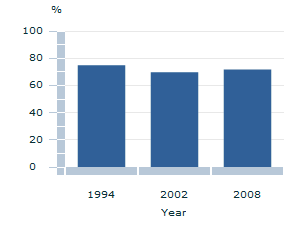
Footnote:
(a) Persons aged 15 years and over.
Source:
ABS National Aboriginal and Torres Strait Islander Survey, 1994 (cat no 4190.0)
ABS National Aboriginal and Torres Strait Islander Social Survey, 2002 and 2008 (cat. no. 4714.0) |  | 
Footnote:
(a) Persons aged 15 years and over.
Source:
ABS National Aboriginal and Torres Strait Islander Survey, 1994 (cat no 4190.0)
ABS National Aboriginal and Torres Strait Islander Social Survey, 2002 and 2008 (cat. no. 4714.0) |
 |  |  |
 |  |  |
 |  |  |
...by age |  | ...by remoteness |
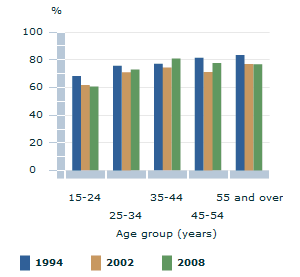
Footnote:
(a) Persons aged 15 years and over.
Source:
ABS National Aboriginal and Torres Strait Islander Survey, 1994 (cat no 4190.0)
ABS National Aboriginal and Torres Strait Islander Social Survey, 2002 and 2008 (cat. no. 4714.0) |  | 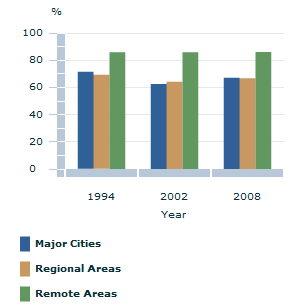
Footnote:
(a) Persons aged 15 years and over.
Source:
ABS National Aboriginal and Torres Strait Islander Survey, 1994 (cat no 4190.0)
ABS National Aboriginal and Torres Strait Islander Social Survey, 2002 and 2008 (cat. no. 4714.0) |
 |  | |